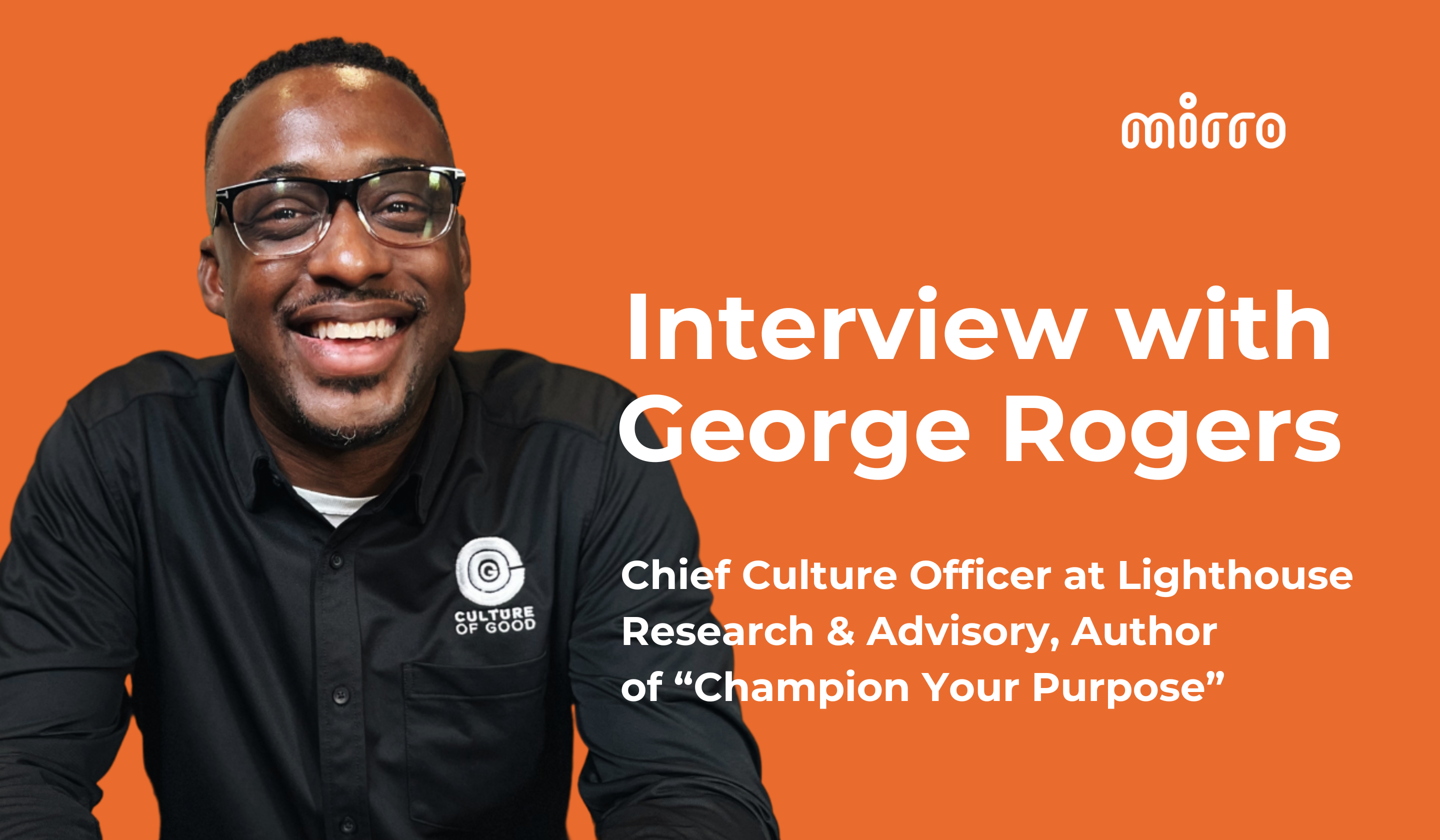SECTION
Mirro Spark: Your Dose of HR Insights From Thought Leaders
.jpeg)
Listen to this article:
The workplace environment is constantly changing, which means that the nature of unpredictability is unquestionably a factor that makes people leaders think of new ways to foster community and belonging.
At Mirro, we're not just focused on creating a thriving community for our team. We want to create a real community with people who share our passions. This is how Mirro Spark was born–a capsule event where we come together with passionate HR leaders to share insights and discuss important issues for the modern workplace.
As such, our first gathering took place on April 25th. If you missed it, we gathered all the hot topics discussed and comprised the lessons in this blog post.
The first Mirro Spark event
Our first capsule event (Mirro Spark: Your Daily Dose of HR Insights) took place at Mirro's headquarters in Bucharest. We gathered with HR leaders to answer all the "whys and hows" of building a culture of continuous feedback.
Below are the key topics covered:
✔️A culture of appreciation starts with continuous feedback;
✔️Pyschological safety is the cornerstone of an environment where people are open to giving and receiving feedback;
✔️People have different preferences when it comes to appreciation, and leaders need to adapt their appreciation style to meet all needs;
✔️It is essential to identify advocates for feedback in the workplace to encourage the practice.
The challenges companies face on their way to feedback culture
We started the event with an open discussion centered on the challenges HR leaders face when incorporating feedback into the company culture.
- Ionela Sulugiuc, National Head of HR at Lidl Romania, broke the ice and talked about the importance of small gestures like daily team huddles, shared lunches, or even greeting each other in the mornings to ensure everyone feels valued and respected at work. Moreover, she pointed out that feedback is closely linked to appreciation and is all about the difficulty of giving it. The only way to solve this is through open conversation and the facilitation of psychological safety in the workplace.
- Marius Ciurariu, HR Director at Provident Financial Romania, continued the dialogue by championing observation and feedback for every team member. From compassionate individual-focused programs (FOS) to fostering a culture of leading with vulnerability, he's all about empowering leaders to influence behaviors and results. As Marius said, culture starts with the leaders and the strategic goals aligned to the mission.
- Mihaela Florescu, Project Manager, People Processes at Vodafone, shared the concept of "five languages of appreciation" and argued that understanding each generation's vibe is key to winning them over because, in the end, everyone wants to receive appreciation in their own unique way.
- Diana Popescu, Talent Manager at MultiversX, emphasized the importance of role modeling from leadership and HR and the chemistry of proximity in building trust and forming genuine connections.
- Ana Radut, HR Business Partner at Pepco, continued with a story about what feedback is from the perspective of her teenage daughter, who learned from TikTok that it is an opinion, a spontaneous reaction. In school, people don't learn what feedback is, and when they enter organizations, HR and managers have to teach them the importance of feedback.
- Irina Neculae, Senior People Engagement Partner at BCR, championed the concept of "magic advisors," a community-driven engagement booster that blurs the lines between team and management. These advisors are either self-proposed or elected and their purpose is to increase engagement within the team.
- Iulia Trica, Talent Acquisition Partner at Raiffeisen, shared a success story of a first-time manager learning to provide feedback, highlighting that consistency is key. The moral of the story is that if you have a successful case study like the one above, you can then get support to sustain a program at the company level.
- Alexandra Parlogea, Head of People at Global Records, emphasized the importance of awareness before initiating change and crafting the right context for each individual. She further compared HR to a guiding spirit that thrives even in its absence.
- Ramona Georgescu, HR Manager at Ascensos, discussed the challenge of real teamwork in a dispersed team spread over many countries.
- Andrei Calotescu, HR Business Consultant at TPARK, elaborated on Ramona's challenge, emphasizing that it is often difficult for colleagues to understand each other when they are distributed across several cities and countries.
- Diana Sorescu, Senior Recruiter at Fieldstar, argued that people only come to HR when they have problems.
.jpeg?width=1200&height=1600&name=WhatsApp%20Image%202024-04-29%20at%205.06.42%20PM%20(4).jpeg) Mirro Spark community
Mirro Spark community
The solution to integrate feedback seamlessly into the culture
One of the most valuable insights from this event was that a feedback-driven culture starts with appreciation. So, before developing strategies to integrate continuous feedback into the organizational culture, you should start with recognition.
To develop a culture of appreciation, people leaders should create a "tipping point" from which appreciation becomes commonplace in the organization and public recognition is spontaneously offered, not just by managers to their teams.
Once you lay the foundations for a culture based on appreciation, you can also focus on developing the feedback area to be continuous, spontaneous, concrete, and constructive.
Here are some practical steps and strategies that emerged during this event that will help every leader seamlessly integrate feedback into the organizational culture, ensuring that it becomes a fundamental aspect of daily operations.
How to foster a culture of recognition
1. Personal example of managers
A pivotal strategy for embedding a culture of recognition is to lead by example. Choose a few managers who believe in the power of appreciation and encourage them to practice it frequently and publicly. When managers model this behavior, it sets a standard for others to follow.
2. Celebrate success together
Celebrating milestones and achievements as a team reinforces collective progress. You can recognize someone for the progress made on a project, milestone achievement, or completed goal. You can start with organizational/departmental successes and then cascade organically to team and individual levels.
3. Incorporate appreciation into performance discussions
Integrating appreciation into performance evaluations and everyday conversations drives continuous growth. Managers should discuss the appreciation their team members receive during performance check-ins, highlight positive feedback, and recognize contributions regularly.
4. Build a culture of appreciation with small gestures
Small gestures, such as congratulating colleagues on work anniversaries, role changes, or birthdays, make appreciation an everyday occurrence. Employee recognition software like Mirro automates these actions, allowing team members to react or comment, further embedding recognition into the organizational fabric.
How to integrate continuous feedback
1. Encourage continuous feedback on various topics
Encourage regular feedback on various topics, from significant issues to everyday matters like office amenities. This way, feedback is normalized in the workplace and becomes a habit. Managers should lead by asking for feedback, creating a ripple effect throughout the organization.
2. Offer training on feedback
Equip managers with the skills to request and give specific feedback effectively. Training programs should focus on clear communication and the importance of reciprocal feedback.
3. Encourage proactive feedback-seeking
Managers should motivate their team members to seek feedback proactively before check-ins. This practice improves individual performance and enhances the overall feedback culture.
4. Measure the effectiveness of recognition efforts and feedback integration
To gauge the effectiveness of your recognition and feedback efforts, start with a simple survey, asking your people how valued they feel by their peers and managers. Ask whether people feel comfortable giving and receiving feedback and if they receive adequate feedback. Repeat this survey every 3-6 months to track changes and gather qualitative insights.
You can get even further with Mirro's Culture Insights, which provides detailed analytics on the number of kudos given, identifies recognition drivers, and highlights those who do not participate in giving or receiving appreciation. This data allows leaders to take targeted actions to enhance their recognition culture.
Mirro's Culture Insights can also be used to analyze feedback dynamics within the organization. By understanding feedback drivers and identifying gaps, leaders can make informed decisions to strengthen their feedback culture.
The bottom line
By implementing these strategies, organizations can foster a workplace environment where appreciation and continuous feedback thrive, driving employee satisfaction and business growth. What actions will you take to integrate these practices into your culture, and how will you measure their success?
We hope you find these highlights useful and instructive, and we encourage you to check out Mirro's upcoming events. We hope to see you very soon!





.jpg)
